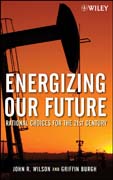
Energizing our future: rational choices for the 21st century
Wilson, John
Burgh, Griffin
This important new book presents a comprehensive review of practical alternative energy choices for the twenty-first century. It addresses three critical energy-related topics that are causing great confusion in public debate-global warming, the hydrogen economy, and nuclear power-and gives readers an opportunity to form a grounded, factually correct foundation for understanding the energy challenge and develop their own informed and actionable opinion INDICE: Preface. Pursuing the Truth. Oil & Gas Consumption. PART I: A TRILOGY OF POPULAR MISCONCEPTIONS. 1. Global Warming. Conventional Wisdom. Global Warming "Forcing Agents". Dealing with Global Warming. Can Anything Be Done?. The Kyoto Protocol. 2. The Hydrogen Economy (Aka, the Impossible Dream). Hydrogen Production Methods. Hydrogen from Hydrocarbons. Natural Gas Reserves and Hydrogen. Transporting and Distributing Hydrogen. Transportation and Distribution Alternatives. Hydrogen Storage. Hydrogen Storage Approaches. Catalyzed Hydrogen Adsorption and/or Desorption. Feasibility of Metal Hydrides as Storage Media. Hydrogen Adsorption/Desorption: "Chemical Hydrides". Hydride Slurries forHydrogen Storage and Transportation. Possible Non-Metal Hydrides/Hydrogen Carriers. Hydrocarbons via Partial Dehydrogenation. Carbon-Based Adsorption Systems. Novel Hydrogen Storage Methods. Hydrogen Carriers. Hydrogen Storage and DOE Criteria. Storage Implications for Light-Duty Vehicles. Hydrogen Storage Assessment. Hydrogen Safety. Summary of Hydrogen Issues. 3. Nuclear Energy and the Plutonium Economy. The influence of Nuclear Energy. Evolution of Reactor Designs. Generation IV Reactors. Fuel Recycling and Mixed Oxide Fuel. MOX Use in Light Water Reactors. MOX Production and Processing. Fast Breeder Reactors. Radioactive Waste Disposal. Uranium Supply Concerns. Uncertainty about Safe and Sustainable Reactor Technology. The Problem in Ontario, Canada. Fusion Power. The Future is Dimming on Nuclear Power. PART II: ENERGY OPTIONS FOR THE FUTURE. 4. Conventional Oil and Oil Reserves. Oil Reserves. Conventional Natural Gas. A Short(age) Summary. Future Supply, Demand and Pricing. Natural Gas and Synthetics. 5. Coal and Bituminous Reserves. Other Coal Processes. Underground Processing of Coal. 6. Biomass and Ethanol. Biomass Conversion Technologies. Conversion Products and By-products. Other Raw Materials for Biomass. Cost Implications of Biomass Use. Net Energy Balances. The Thermodynamics of Growing Corn. Corn Production in the United States. Federal Subsidies for Ethanol. Longer-term Ethanol Prospects. Final Ethanol Observations. 7. Methanol. Possible Fossil Sources of Syngas. Methanol as an Energy Carrier. Methanol Manufacturing and Applications. 8. Diesel and BioDiesel. "Clean Diesel" Fuel and Diesel Fuel Substitutes 152. Biodiesel. 9. Solar Energy and Photovoltaics. Solar Radiation.Solar Photovoltaic Systems. General Operation of PV Cells. Polycrystalline Thin-film Materials. Dye-sensitized Solar Cells. 10. Fuel Cells for Stationary and Mobile Use. Real-world Fuel Cell Efficiencies. User Expectations. On-board Fuel Storage Requirements. Appendix - Terms and Definitions.
- ISBN: 978-0-471-79053-2
- Editorial: John Wiley & Sons
- Encuadernacion: Cartoné
- Páginas: 390
- Fecha Publicación: 01/02/2008
- Nº Volúmenes: 1
- Idioma: Inglés
